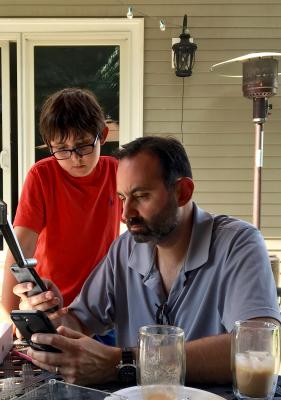The best digital health lesson a 10-year-old ever taught me

David Feygin, PhD, MBA, vice president, Information Technology, and Chief Digital Health Officer
Everything seemed fine when my son came home from school. He didn’t share much, admittedly—but the monosyllables and grunts all seemed affirmative, and certainly not out of character for a tween boy. But when bedtime rolled around and it was time to turn off Fortnite, though, it was a different story (and longer, though only marginally).
I started hearing about what a terrible day it had been. I listened, and learned more. A classmate had attacked his hairstyle—he couldn’t, or wouldn’t, recall the details of what had led up to the event, whether he had said anything. For him, the history was unrelated to the outcome. What mattered was the assault. And however self-focused this particular young narrator may have been, his takeaway was simple: it was big, bad and personal. And it necessitated a long discussion that evening—albeit one that was short on detail.
Naturally, I responded like any sensible, logical and well-reasoned engineer: I fired off a nastygram to his teacher loaded with words like “unacceptable” and “bullying,” calling for a stronger safety net to protect my sweet, loving child and others like him whose hairstyles were simply too cool to be appreciated by tasteless peers.
The response came quickly: his teacher was, in fact, aware, and suggested that my wife and I come in for a deeper discussion. Shuffled schedules and canceled meetings later, we learned what you, clever reader, may have already suspected. It turns out that the context did matter: he started it. And the end-of-day storytelling may have been as much “stay up late” ploy as real grievance after all.
I ignored a dearth of information, context and causal data, and took at face value the perspective of the most important—but most biased—party involved. Before doing the work to more fully understand the situation, I jumped to a conclusion that suited my own narrative. My solution felt satisfying for a moment—but did it really help my son learn to navigate the delicate negotiations of middle school (or bedtime)? Not even close.
It’s a pitfall as common, and as hazardous, for digital health professionals as it is for parents.
In healthcare, we are constantly dealing with limited data and biased information, and the results can compromise patient care. From unnecessary procedures where the outcomes are not meaningfully measured to missed opportunities to better manage chronic conditions because we aren’t capturing the patterns, our practices have to catch up to the opportunity. By default, patients are at the center of their own experiences, and their perspectives are essential—but that doesn’t mean they can always see the connections between symptoms and causes.
The power of digital health is that we can make those connections—we can track the data, help patients see the patterns, and most importantly, help them take action that will improve their quality of life. From continuous glucose monitors to apps that help manage conditions like inflammatory bowel disease, understanding the cause and effect is at the key of better decision-making. And it’s something that most of us are woefully imperfect at doing on our own.
We want to be heroes for patients in the same way that I want to be a hero for my son—but better information will get us there, not rash decisions based on filling in the blanks ourselves. We have to set aside our first instincts to drill deeper, and challenge our own preconceptions and biases in order to hear what isn’t being said.
If we only respond to the topline request, we won’t deliver meaningful care solutions. In my son’s case, the solution that made him happier wouldn’t come from a meeting with the teacher—it came from a negotiated bedtime routine and a fun day out with his “bullies” over the weekend. It’s our obligation to dig in and understand the need behind the ask. We need multiple datasets from multiple perspectives, delivered as quickly and seamlessly as possible to enable fast decision-making.
We simply cannot afford to jump to conclusions. After all, the stakes in our business are much higher than missed bedtimes.